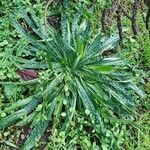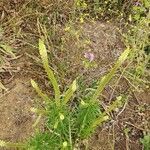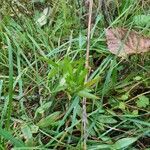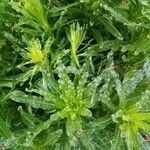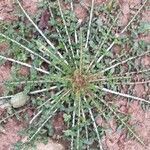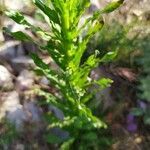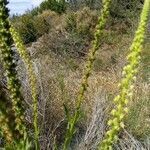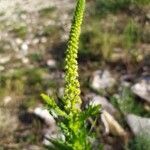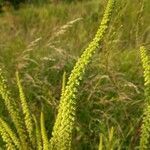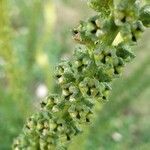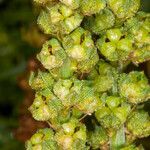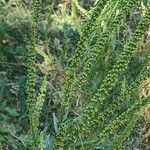Plants annual or biennial, (20-)40-100(-150) cm, glabrous. Stems erect, simple or branched. Leaves (cauline subsessile dis-tally); blade oblong-spatulate, 5-10(-15) × 0.5-2 cm, margins entire or subentire (flat or crispate), surfaces glabrous or, sometimes, with 1-2 conical glands basally. Racemes 10-50 cm; bracts persistent, lanceolate-attenuate, 2-3.5 mm (4-5 mm in fruit). Pedicels 1-3 mm. Flowers: sepals persistent, 4, not reflexed in fruit, lanceolate-ovate, 1-2.5 mm; petals 4, yellowish, 2-4 mm, rounded-clawed, adaxial ones irregularly lobed; stamens 20-40; filaments persistent, 2-3 mm, glabrous; intrastaminal nectary-discs glabrous; anthers 0.5-0.6 mm; placenta forked distally. Capsules erect, 3-carpelled, ovoid to subglobose, 3-5 × 4-6 mm, apically 3-toothed, usually glabrous. Seeds 0.6-1 mm, glossy, smooth. 2n = 24, 26.
Biennial glabrous taprooted herb, 50-150 cm tall; rootstock ± woody; stem erect, ribbed, hollow, simple or sparingly branched. Lvs simple, entire, with undulate margins. Basal lvs narrow-oblanceolate, cuneate, (3)-6-12-(25) × 0.5-1.5-(2.5) cm; cauline lvs linear to narrow-oblong, the lower cuneate, the upper more abruptly narrowed, 2-7-(10) × 0.2-1-(2) cm. Pedicels ascending, c. 1-2.5 mm long. Sepals 4, ovate. Petals (3)-4-(5), yellowish green; limb of posterior petal 4-8-lobed, of laterals and anterior entire or 4-lobed. Stamens 20-25; filaments persistent. Capsule cup-shaped, with sparsely tubercled lateral ridges, 3-5-(6) × 3-5-(6) mm long; carpels 3. Seeds brownish black, smooth, shiny, 0.8-1 mm long.
With entire lvs, short pedicels, and 4 pet that are merely toothed or cleft, is occasionally adventive from Europe.
A herb.
